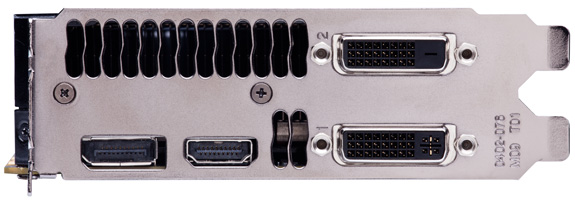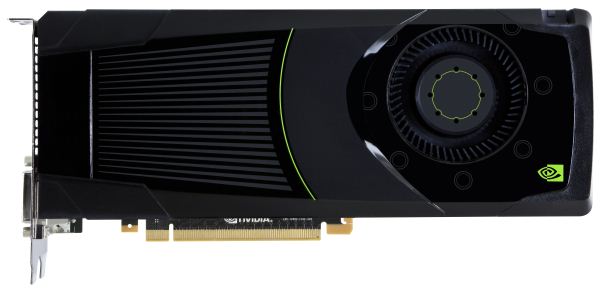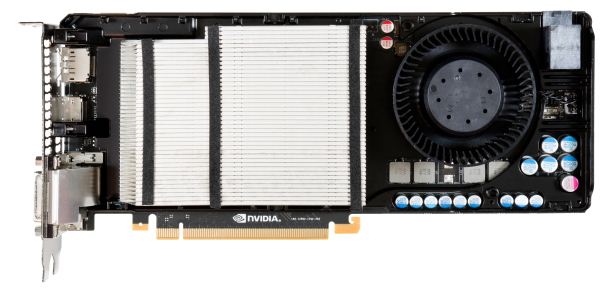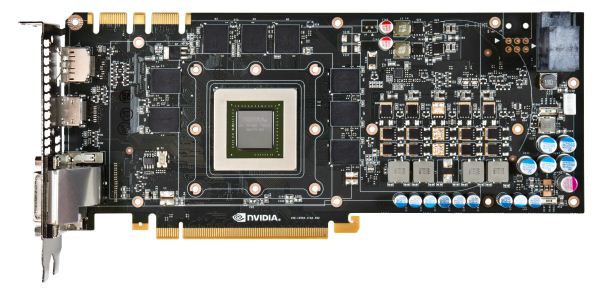NVIDIA GeForce GTX 680 Review: Retaking The Performance Crown
by Ryan Smith on March 22, 2012 9:00 AM ESTMeet the GeForce GTX 680
All things considered the design of the GeForce GTX 680 is not a radical departure from the GTX 580, but at the same time it also has some distinct differences owing to the fact that its TDP is some 50W lower than GTX 580.
Like the past GTX x80 cards, the basic design of the GTX 680 is that of a blower. A radial fan at the rear of the card sucks in air and pushes it towards the front of the card. Notably, due to a combination of card length and the fan position, the “wedge” around the fan has been done away with. NVIDIA tells us that this shouldn’t significantly impact the cooling of the card, particularly since it has a lower TDP in the first place, but when used in SLI it will remove some of the breathing room than the GTX 580 enjoyed.
Looking at the fan itself, compared to the GTX 580 the fan has been moved from the center of the card to the top of the card. This is due to NVIDIA’s port configuration, which uses a stacked DVI connector that consumes what would have normally been part of the exhaust vent on the GTX 580. We’ll get into the port configuration more in a minute, but for the moment the significance is that because the GTX 680 only has half a vent NVIDIA has moved the fan to match the vent, which is why the fan has been moved up.
On that note, the repositioning of the fan also had its own ramifications. Because the fan is now so close to the top and at the same time so close to the rear, NVIDIA went with a unique method of arranging the PCIe power sockets. Rather than having them side-by-side as we’ve seen on countless NVIDIA cards in the past, the sockets are stacked on each other in a staggered configuration. With the fan otherwise occupying the space that one of the sockets would take up, this configuration allowed NVIDIA to have two sockets without lengthening the card just to fit another socket. Overall this staggered design is not too difficult to work with, though with one socket facing the opposite way it might require some cable repositioning if you have a well maintained cable run.
Moving on, when we remove the shroud on the GTX 680 we see the fan, baseplate, and heatsink in full detail. NVIDIA is using an aluminum fin stacked heatsink, very similar to what we saw on the GTX 580. Underneath the heatsink NVIDIA is using a set of three heatpipes to transfer heat between the GPU and the heatsink. This is as opposed to the vapor chamber on the GTX 580, and while this setup doesn’t allow empirical testing, given the high efficiency of vapor chambers it’s likely that this isn’t quite as efficient, though to what degree we couldn’t say.
Finally, after removing the fan, baseplate, and heatsink, we can see the PCB in full detail. Unlike GF110 and GF114, GK104 is not capped with an IHS, allowing for the heatsink to directly come in contact with the GPU die. Meanwhile arranged around the GPU we can see the 8 2Gb GDDR5 RAM modules that give the GTX 680 its 2GB of RAM. These are Hynix R0C modules, which means they’re rated for 6GHz, the stock memory speed for the GTX 680. Overall the card measures 10” long with no overhang from the shroud, making it 0.5” shorter than the GTX 580.
Looking at the top of the card, as always we see the SLI connectors. Following in the footsteps of the GTX 580, the GTX 680 features 2 SLI connectors, allowing for up to 3-way SLI.
Meanwhile at the front of the card we see the I/O bracket. As we alluded to previously, the GTX 680 uses a stacked DVI design here; NVIDIA has done everything they can to keep the DVI ports at the very bottom of the card to avoid impeding airflow, but the upper DVI port still occupies roughly 40% of what would otherwise be the vent. Altogether the GTX 680 features 2 DL-DVI ports, a full size HDMI port, and a full size DisplayPort.

While NVIDIA has used DVI and HDMI ports for quite some time, this is the first time NVIDIA has included DIsplayPort on a reference design. Unfortunately we find that this ruffles our feathers a bit, although this isn’t strictly NVIDIA’s fault. As we’ve covered in the past, DisplayPort comes in both a full size and miniDP configuration – AMD in particular has used miniDP since the Radeon HD 6800 series in 2010. And while we’re happy to see DisplayPort finally make it into an NVIDIA reference design, the fact that it’s a full size DisplayPort is less than encouraging because at this point in time DisplayPort has largely been replaced by miniDP.
Ultimately the fault for this lies more with the VESA than NVIDIA, but it’s indicative of a larger problem in the DisplayPort community in that both full size DP and miniDP are equally valid and equally capable ports. While full size DisplayPort has the distinction of coming first, thanks in large part to Apple it has largely been displaced by miniDP as the most common variant on source devices. The problem with this is that both miniDP and DisplayPort are now in wide use; wide, redundant use.
At this point desktop computers and video cards coming with full size DisplayPorts is silly at best, and frustrating at worst. The laptop guys aren’t going to give up miniDP due to the space savings, and there’s no significantly good reason to use DisplayPort on desktops when miniDP offers the same functionality. We would rather see the PC industry standardize on miniDP across all source devices, and thereby eliminate any ambiguity with regards to what cables or adaptors are necessary. DisplayPort adoption has been slow enough – having 2 variants of the port on source devices only makes it more confusing for everyone.
Finally, while we’re on the subject of display connectivity we quickly took a look at how the idle clockspeeds of GTX 680 are impacted by the use of multiple displays. With 2 displays GTX 680 can utilize its full idle clocks, but only if both displays are connected via a TMDS type connection (DVI/HDMI) and run with identical timings. But if different timings are used or if one display is connected via DisplayPort, then the GTX 680 will shift to its low power 3D clocks. However if we expand that to 3 monitors and enable NVIDIA Surround, then the GTX 680 can operate at full idle regardless of whether DisplayPort is used or not.













404 Comments
View All Comments
Sabresiberian - Thursday, March 22, 2012 - link
Do you work for AMD's marketing department, or are you just a fanboy with tunnel vision?silverblue - Thursday, March 22, 2012 - link
Could be beenthere under a different name... ;)CeriseCogburn - Thursday, March 22, 2012 - link
Youtube has settled that lie - all the "bumpgate" models have defectively designed heatsinks - end users are inserting a penny (old for copper content) above the gpu to solve the large gap while removing the laughable quarter inch thick spongepad.It was all another lie that misplaced blame. Much like the ati chip that failed in xbox360 - never blamed on ati strangely.... (same thing bad HS design).
Arbie - Thursday, March 22, 2012 - link
IMHO the only game worth basing a purchase decision on is Crysis / Waheard. There, even the 7950 beats the GTX680, especially in the crucial area of minimum frame rate. The AMD cards also take significantly less power long-term (which is most important) and at load. They are noisier under load but not enough to matter while I'm playing.
So for me it's still AMD.
kallogan - Thursday, March 22, 2012 - link
Don't know if you can say that. Crysis is old now. No directx 11. But it's true the GTX 680 does not particularly shine in heavy games like Metro 2033 or Crysis warhead compared to other games that may be more Nvidia optimised like BF3.CeriseCogburn - Tuesday, March 27, 2012 - link
Except in the most punishing benchmark Shotun 2 total War, the GTX680 by Nvidia spanks the 7970 and wins at all 3 resolutions !*
*
Can we get a big fanboy applause for the 7970 not doing well at all in very punishing high quality games comparing to the GTX680 ?
Sabresiberian - Thursday, March 22, 2012 - link
The key phrase you use here is "where it matters to me". I wouldn't argue with that at all - your decision is clearly the right one for your gaming tastes.That being said, you change your wording a bit, and it seems to me to imply (softening it "IMHO") that everyone should choose by your standards; that is also clearly wrong. The games I play are World of Warcraft, and Skyrim. WoW test results can be best compared to BF3, of those benches that were used in this article. I've never played Crysis passed a demo - so choosing based on that benchmark would be shooting myself in the proverbial foot.
Clearly, the GTX 680 is the better choice for me.
I've always said, choose your hardware by application, not by overall results (unless, of course, overall results matches your application cross-section :) ), and the benches in this article are more data to back up that recommendation.
;)
3DoubleD - Thursday, March 22, 2012 - link
Please don't buy a GTX 680 for WoW...It's even overkill for Skyrim, since you don't really need much more than 30 fps. You'd be fine using more economical variants.
CeriseCogburn - Thursday, March 22, 2012 - link
Wrong, but enjoy your XFX amd D double D.The cards, all of them, are not good enough yet.
Always turning down settings and begging the vsync.
They all fail our current gams and single monitor resolutions.
Iketh - Thursday, March 22, 2012 - link
for pvp you most certainly do need more than 30 FPS, try 60 at the least and 75 as ideal with a 120hz monitor... the more FPS I can get, the better I perform... your statement is true for raiding only